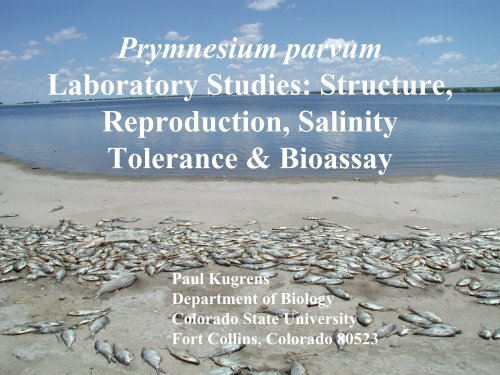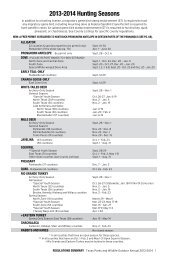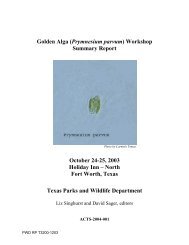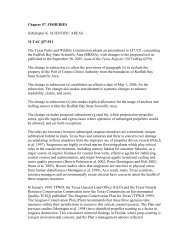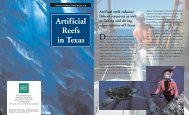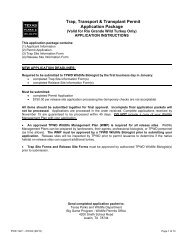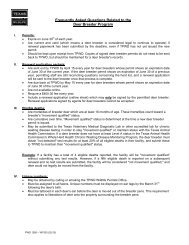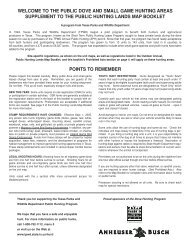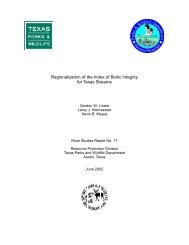Download presentation - Texas Parks & Wildlife Department
Download presentation - Texas Parks & Wildlife Department
Download presentation - Texas Parks & Wildlife Department
You also want an ePaper? Increase the reach of your titles
YUMPU automatically turns print PDFs into web optimized ePapers that Google loves.
Prymnesium parvum<br />
Laboratory Studies: Structure,<br />
Reproduction, Salinity<br />
Tolerance & Bioassay<br />
Paul Kugrens<br />
<strong>Department</strong> of Biology<br />
Colorado State University<br />
Fort Collins, Colorado 80523
News Release<br />
• May 28, 2002 - massive fish kill in Prewitt<br />
Reservoir in Colorado<br />
• 500,000+ fish were killed<br />
• Prymnesium implicated<br />
– Water had a golden brown color<br />
– Identification based on descriptions provided by<br />
fisheries personnel in <strong>Texas</strong> via telephone
News of Massive Fish Kill at Prewitt<br />
Reservoir in Colorado
Fish Kill at Prewitt Reservoir
6-5-02<br />
Catch of the Day
Pelicans putative of transport agents<br />
of Prymnesium to Colorado
Golden-Brown Color of the<br />
Water
Objectives of this Presentation<br />
• To provide cytological data for<br />
Prymnesium<br />
• To provide information on cyst<br />
formation<br />
• To determine range of salintity<br />
tolerances for three strains<br />
• To induce cyst formation and to<br />
determine cyst structure
Objectives of this Presentation<br />
(Continued)<br />
• To describe a simple hemolytic bioassay<br />
technique<br />
• To propose a mechanism for increased<br />
growth in high pH conditions<br />
• To explore possible biocontrol for<br />
Prymnesium<br />
• To determine whether mixotrophy occurs<br />
– Photosynthetic organisms ingesting cells<br />
– Mixed nutrition
Prymnesium Strains in Culture<br />
• UTEX - 995 Plymouth, England<br />
• <strong>Texas</strong> Isolate<br />
• <strong>Texas</strong> Isolate Lubbock Canyon<br />
• Wyoming Isolate Twin Buttes Lake<br />
• Latvian isolate - Jurmala, Baltic Sea
Strains of Prymnsium parvum<br />
Used in this Study<br />
• UTEX - 995<br />
• <strong>Texas</strong> Isolate<br />
• Wyoming Isolate - Twin Buttes Lake
Structure of Prymnesium
Haptonema<br />
Flagellum<br />
SEM
<strong>Texas</strong> Prymnesium parvum<br />
Haptonema<br />
Note the obovate shape of the cells
Haptonema<br />
Scales
Chloroplast<br />
Nucleus
Cyst Formation<br />
• A variety of conditions failed to induce<br />
cyst formation<br />
• Cold<br />
• Dark<br />
• Nutrient depletion periods<br />
• Desiccation<br />
• Nutrient
Media Used<br />
• Medium Variations<br />
• Twin Buttes water (high salinity – primarily<br />
calcium sulfate)<br />
• Prewitt Reservoir Water (low salinity)<br />
• Dowdy Lake water (low salinity)<br />
• Seawater<br />
• Artificial Seawater Medium
Growth Observations 0n<br />
Prymnesium strains from <strong>Texas</strong> &<br />
Wyoming<br />
• Grew well in following media & salt<br />
concentrations<br />
– Twin Buttes – 11 ppt<br />
– SW – 32 ppt<br />
– Buffalo Spring Lake – 11 pt<br />
– Lubbock Canyon Lake - 6 ppt<br />
• No Growth<br />
– Dowdy Lake Water – >1 ppt<br />
– Prewitt Reservoir – 1 ppt<br />
– Cells hypertrophied & burst within 10 minutes
Salinity Tolerance<br />
Used Artificial Seawater Medium<br />
at Different Salinities – 32, 16, 8, 4,<br />
and 1 ppt
Prymnesium Twin Buttes Lake, Wyoming<br />
UTEX 995 Prymnesium<br />
1200000<br />
900000<br />
1000000<br />
800000<br />
700000<br />
Cells/mL<br />
800000<br />
600000<br />
400000<br />
32 ppt<br />
16 ppt<br />
8 ppt<br />
4 ppt<br />
Cells/mL<br />
600000<br />
500000<br />
400000<br />
300000<br />
32 ppt<br />
16 ppt<br />
8 ppt<br />
4 ppt<br />
200000<br />
200000<br />
100000<br />
0<br />
0 8 13 17 21 24 28 36<br />
0<br />
0 8 13 17 21 24 28 36<br />
Day<br />
Day<br />
2500000<br />
<strong>Texas</strong> Prymnesium<br />
Definite Salinity<br />
Effect<br />
Cells/mL<br />
2000000<br />
1500000<br />
1000000<br />
500000<br />
32 ppt<br />
16 ppt<br />
8 ppt<br />
4 ppt<br />
0<br />
0 8 13 17 21 24 28 36<br />
Day<br />
No growth in 1 ppt for any of the strains
Summary of Salinity Experiments<br />
• All grew well in 32 ppt<br />
• <strong>Texas</strong> Prymnesium grew rapidly and had the<br />
highest numbers/ml<br />
– Maintained cell numbers between .5 – 1.25 million<br />
cells/mL at the end of the experiments<br />
• Strain 995 grew best at 32 ppt but growth<br />
decreased correspondingly with lower salinities<br />
• <strong>Texas</strong> & Wyoming Prymnesium grew well in all<br />
salinities tested
Hemolytic Bioassay Procedures<br />
• 5 ml of cultures placed into culture tubes<br />
• Cultures centrifuged and supernatant discarded<br />
• 1 ml of Ringer’s Solution added<br />
• Cells lysed by vortexing with small glass beads & by<br />
freezing and thawing<br />
• 3 ml of Ringer’s Solution and 1 ml of heparinized<br />
canine blood were added & mixed with solution<br />
• Placed on ice for 1 minute<br />
• 10 µl samples were examined microscopically to<br />
determine the number of lysed cells/unit area using<br />
a Palmer Chamber & Whipple ocular grid
Hemolysis Observations<br />
Control<br />
Prymnesium Lysate<br />
RBC
Hemolysis Bioassay<br />
• Alga Medium Phase % Lysed Red Blood Cells<br />
• Diacronema SW/TB 10/20/30 days (Control) 0 %<br />
• P. parvum (Tx) SW 10 Days 3.8 %<br />
• P. parvum (Tx) SW 20 Days 100%<br />
• P. parvum (Tx) SW 30 Days 100%<br />
• P. parvum TB 10 Days 4.2 %<br />
• P. parvum TB 20 Days 100%<br />
• P. parvum TB 30 Days 100%<br />
• C. parva RF DL 10 Days 4.0 %<br />
• C. parva RF DL 20 Days 0 %<br />
• C. parva RF DL 30 Days 0 %<br />
• C. parva SDB DL 10 Days 0 %<br />
• C. parva SDB DL 20 Days 0 %<br />
• C. parva SDB DL 30 Days 8.1 %
Hemolysis Summary<br />
• Hemolyis of canine red blood cells in<br />
Chrysochromulina & Diacronema lysates<br />
insignificant<br />
• 100% hemolysis of canine red blood cells<br />
occurred with P. parvum lysates from<br />
<strong>Texas</strong> & Wyoming
Mixotrophy Studies<br />
• Several phytoplankton grown with<br />
Prymnesium<br />
• Observed daily with inverted light<br />
microscopy & transmision electron<br />
microscopy (1000’s of cells)<br />
• No evidence of mixotropy in any of the<br />
three strains used in this study
Hypothesis for Rapid Growth<br />
of Prymnesium<br />
• Prymnesium thrives in a wide range of<br />
salinities with different salts<br />
• Rapid growth at high pHs – e.g. 8.2<br />
– Becomes dominant phytoplankter<br />
• Nutrients available to other<br />
phytoplankton<br />
• Limiting Factor might be carbon dioxide<br />
availability
Chloroplast Endoplasmic Reticulum<br />
Nucleus
Adaptive Advantage of Chloroplast Endoplasmic<br />
Reticulum – Carbon Dioxide Utilization?
Adaptive Advantage of Chloroplast<br />
Endoplasmic Reticulum – Carbon<br />
Dioxide Utilization?<br />
• Dissolved Inorganic Carbon (DIC)<br />
availability might promote rapid growth<br />
of Prymnesium<br />
• Chloroplast Endoplasmic Reticulum<br />
might provide a ready source of carbon<br />
dioxide for the Calvin Cycle<br />
• Would impart an adaptive advantage<br />
over algae that lack a CER
Biocontrol of Prymnesium?<br />
• Organisms that selectively ingest other<br />
organisms<br />
• Kathablepharis – small colorless flagellate<br />
that feeds on another Prymnesiophyte,<br />
Chrysochromulina<br />
• Can ingest 4-10 cells<br />
• Attack in groups of 5-several hundred
10 µm<br />
Kathablepharis sp.<br />
Courtesy of<br />
Steve Barlow<br />
Kathablepharis ovalis<br />
Ingested<br />
Alga<br />
10 µm
Chrysochromulina Haptonema<br />
Coiled Haptonema<br />
Pyrenoid
Chrysochromulina parva<br />
Long, uncoiled<br />
Haptonema<br />
SEM<br />
Flagellum
Chrysochromulina parva
Ingested Chrysochromulina & some bacteria in Kathablepharis
Biocontrol of Prymnesium?<br />
• Kathablepharis ovalis could be isolated &<br />
exposed to Prymnesium to see if the selective<br />
feeding response can be adapted<br />
• Grows at salinities that Prymnesium tolerates<br />
• Has been implicated in Chrysochromulina<br />
bloom disappearance<br />
• Decimates dense Chrysochromulina cultures<br />
within two weeks<br />
• Not found in any of <strong>Texas</strong> samples examined
Return to Prewitt<br />
• Prymnesium parvum was marine in origin<br />
• Able to grow inland only in high salinity waters<br />
– Grew equally well in seawater & Twin Buttes media<br />
– Calcium sulfate most common salt in plains lakes of<br />
Wyoming – salinity 11 ppt<br />
• In <strong>Texas</strong> due to increase in the salinity of<br />
freshwater<br />
– By evaporation & agricultural runoffs<br />
– Buffalo Springs 11 ppt<br />
– Lubbock Canyon Reservoir – 6 ppt
Prewitt Reservoir Explanation<br />
• Presence of Prymnesium never<br />
confirmed.<br />
• Low salinity in Prewitt precludes growth<br />
of Prymnesium – 1 ppt<br />
• Therefore, what could have caused the<br />
fish kill in Prewitt Reservoir?
Prewitt Reservoir Fact<br />
• Five days following fish kill<br />
• Phytoplankton bloom consisted of over<br />
4.5 billion cells/Liter
Mystery<br />
• Samples taken 5 days after the fish kill did not<br />
reveal any Prymnesium<br />
• One week old samples also were examined<br />
– Collected by Colorado Division of <strong>Wildlife</strong> Fish<br />
Pathologist & kept refrigerated<br />
– Did not reveal any Prymnesium<br />
– A few cells of Chrysochromulina sp. were noted<br />
• Lack of Prymnesium attributed to a sudden dieoff<br />
of this alga after the fish kill (5 days?)
Prewitt Reservoir Explanation<br />
• Phytoplankton bloom five days after the<br />
fish kill consisted of over 4.5 billion<br />
cells/Liter<br />
– Dominated by cryptomonads<br />
– Campylomonas reflexa<br />
– Plagioselmis nanoplanctica
Dominant Cryptomonads<br />
Campylomonas reflexa<br />
Plagioselmis nanoplanctica
Prewitt Mystery Solved?<br />
• Campylononas &/or Plagioselmis could<br />
be a toxin producing algae<br />
• Due to high algal cell numbers the fish<br />
kill could be due to oxygen depletion<br />
– Primarily due to abundance of<br />
cryptomonads, not Prymnesium!!!!!<br />
– DO was not determined at the time of the<br />
fish kill
Solution to Fish Kill<br />
Mass<br />
Burial<br />
6-7-02
Future Prymnesium Problems<br />
in Wyoming?<br />
• Isolated from highly productive trout lakes<br />
• Decline in fishery observed in Twin Buttes Lake?<br />
• Could spread north & east through interconnected<br />
waterways


